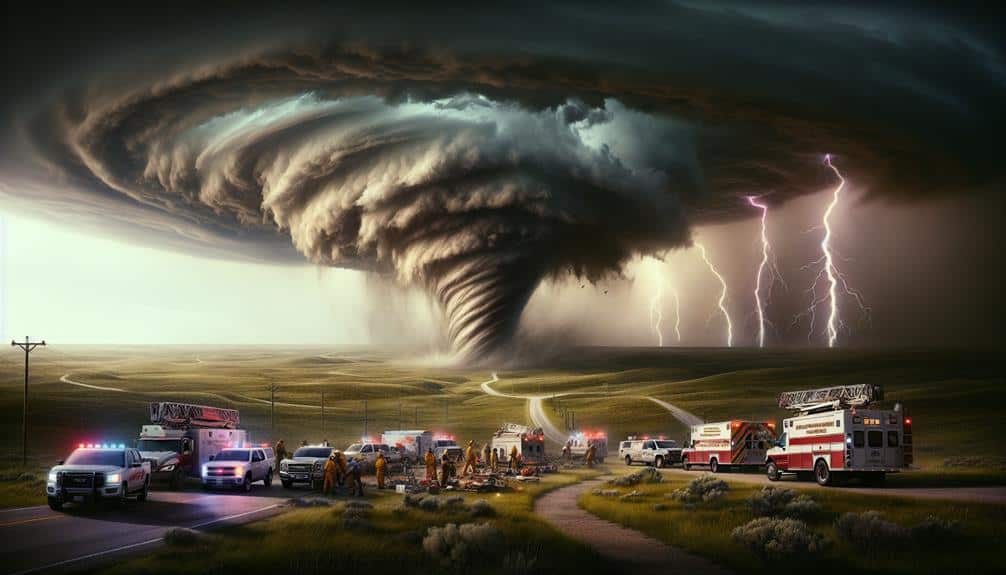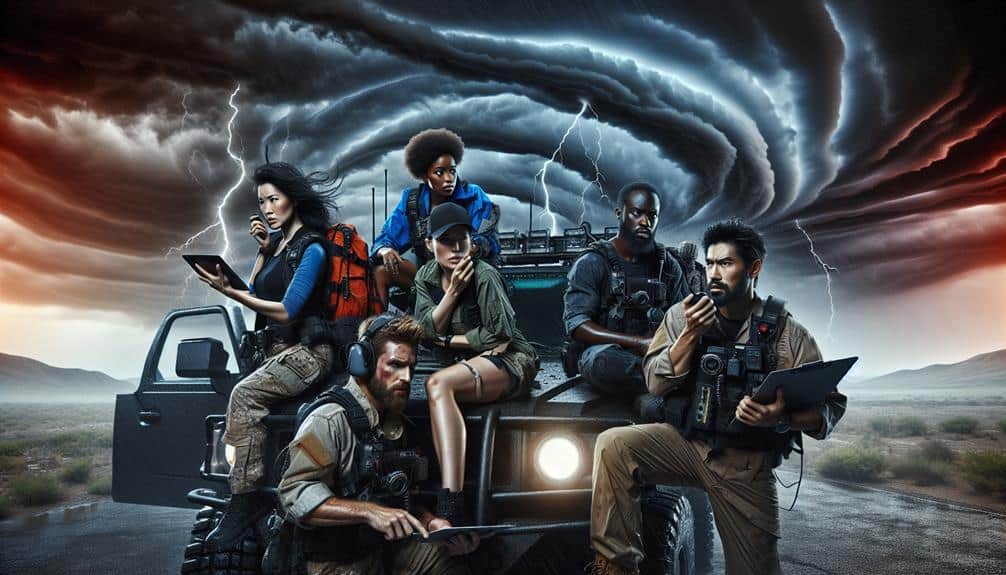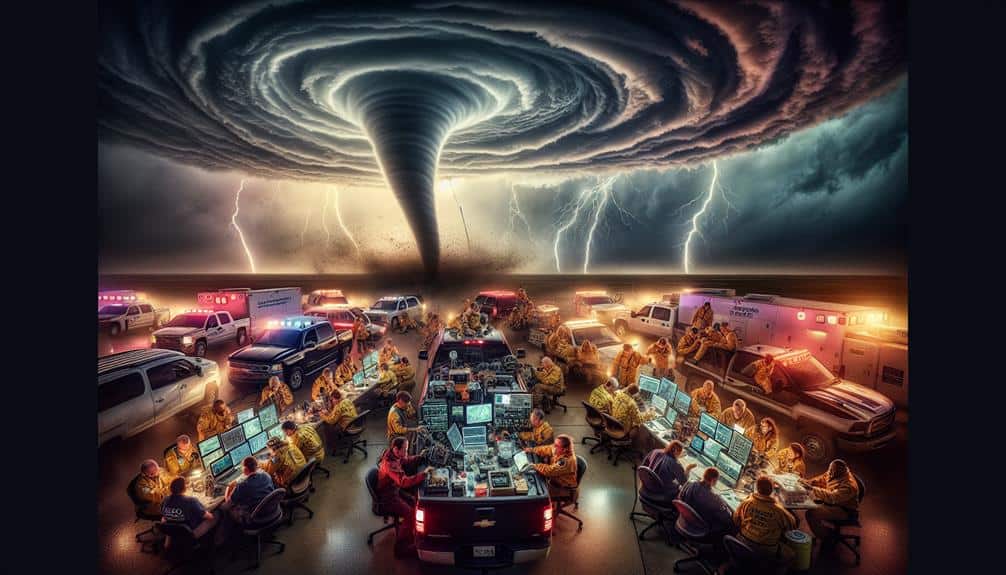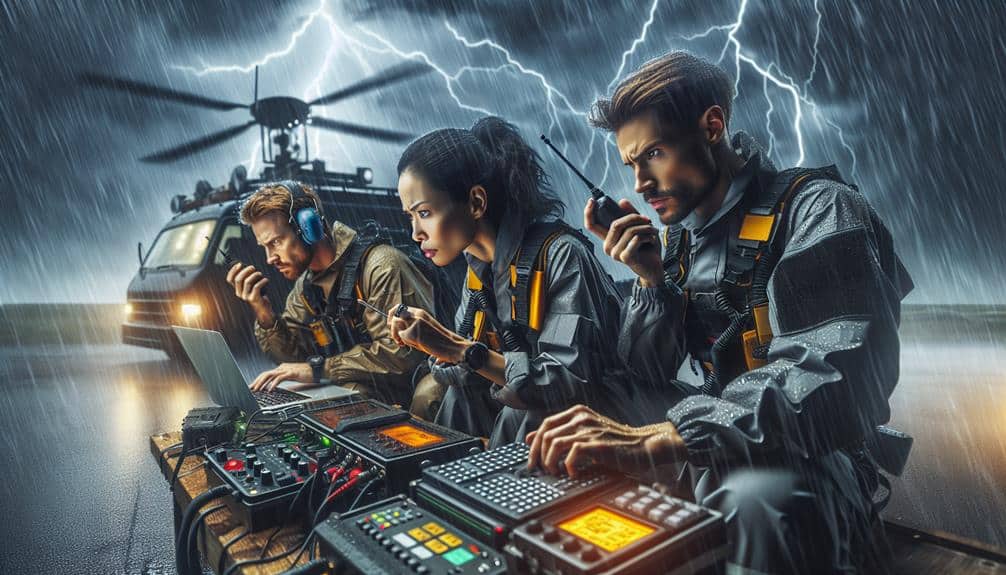In storm chasing, coordinating between teams is vital because it enhances our safety, boosts data accuracy, and optimizes resource allocation. We use advanced communication systems to share real-time data, ensuring everyone is informed and can make strategic decisions quickly. By synchronizing our efforts, we prevent overlapping coverage and deploy equipment effectively. Unified emergency protocols and constant drills further streamline our responses, reducing risks in rapidly changing conditions. This collective approach not only improves situational awareness but also fosters trust and collaboration within our teams. By understanding these dynamics, you'll see why coordination is the backbone of effective storm chasing.
Key Points
- Enhances safety by ensuring rapid information exchange and precise team communication.
- Facilitates real-time data sharing for informed decision-making and improved situational awareness.
- Optimizes resource allocation by minimizing overlapping coverage and deploying equipment efficiently.
- Reduces communication gaps through standardized protocols and unified response strategies.
Enhancing Safety Measures
Implementing advanced communication systems is vital for enhancing safety measures among storm chasing teams. By integrating robust communication tools, we facilitate collaborative planning, ensuring every member remains informed and prepared. We can't afford miscommunication when maneuvering volatile weather systems; precise team communication minimizes risks and maximizes efficiency.
In our field, rapid information exchange is essential. Advanced systems allow us to maintain constant contact, sharing critical updates and coordinating our movements. These tools support us in executing well-defined strategies, reinforcing our collective safety. Coordinated efforts mean we're not duplicating tasks or stepping into hazardous zones unknowingly.
Effective team communication also empowers us to adapt quickly to changing conditions. When storm paths shift unexpectedly, we need to reallocate resources and adjust plans on the fly. Advanced communication systems provide the agility required to pivot strategies without compromising safety. By leveraging these systems, we enhance our ability to make informed decisions collectively.
Through the use of these sophisticated tools, we foster a culture of trust and reliability. Our safety measures become more robust, and our operations more seamless, ultimately granting us the freedom to chase storms with confidence and precision.
Sharing Real-Time Data
Sharing current data is essential for synchronizing our efforts and making informed decisions during storm chases. By exchanging up-to-date information, we enhance data accuracy, guaranteeing we're all working from the same reliable sources. This precision is vital when monitoring rapidly evolving storm conditions. Accurate data allows us to maintain a rapid response, enabling us to adapt quickly to sudden changes in weather patterns.
Strategic positioning is another critical aspect that benefits from sharing real-time data. When we're aware of each team's location and movement, we can cover more ground efficiently without duplicating efforts. This strategic coordination allows us to place ourselves in ideal positions for data collection and safety.
Improved communication is essential in this situation. By utilizing advanced communication tools, we make sure that information flows seamlessly among teams, reducing the risk of misunderstandings and enhancing our collective situational awareness.
Optimizing Resource Allocation
When we optimize resource allocation, we guarantee efficient equipment deployment and minimize overlapping coverage. This strategic approach enhances data collection by maximizing the unique observations each team can provide.
As a result, our coordinated efforts yield more thorough and valuable meteorological insights.
Efficient Equipment Deployment
To maximize the efficiency of our storm chasing operations, we need to strategically allocate our equipment based on real-time data and predictive models. By leveraging these tools, we guarantee a timely response and optimum strategic positioning, which are crucial for capturing critical storm data.
Our approach involves deploying Doppler radar units, anemometers, and other meteorological instruments precisely where they're needed most. Real-time data streams from satellites and weather stations guide us in making minute-by-minute decisions. We use predictive models to forecast storm paths, allowing us to position our equipment ahead of time, maximizing our data collection while minimizing risk.
Coordination between teams is essential. We maintain constant communication to avoid redundant deployments, guaranteeing each piece of equipment is utilized to its fullest potential. This collaborative effort enables us to cover larger areas more effectively, gathering comprehensive data sets from different vantage points.
Additionally, we prioritize flexibility. Our deployment strategies are adaptable, allowing us to reposition equipment swiftly as new data comes in. This agility ensures our operations aren't only efficient but also resilient to the unpredictable nature of storms. By doing so, we maximize the utility of our resources, providing richer, more accurate storm data.
Minimized Overlapping Coverage
We carefully plan our equipment placements to minimize overlapping coverage, guaranteeing that each instrument's data collection zone is distinct and maximally productive. This strategic planning is essential for optimizing resource allocation and achieving improved efficiency in our storm chasing endeavors. By carefully analyzing geographical and meteorological data, we can position our teams and tools in a way that maximizes data quality and coverage.
Our approach involves using sophisticated mapping software and real-time communication to coordinate the positions of radar units, anemometers, and other necessary equipment. This ensures that no two instruments are redundantly capturing the same data, freeing up valuable resources for wider area coverage. Each team's unique data collection zone allows us to gather thorough atmospheric information while avoiding redundant efforts.
Furthermore, minimizing overlapping coverage enhances our capacity to adapt swiftly to changing weather conditions. With precise, non-overlapping zones, we've got the flexibility to redeploy equipment efficiently, maintaining our operational freedom and responsiveness. This method isn't just about efficiency; it's about maximizing our collective potential to understand and predict storm behavior, ultimately leading to more effective and safer storm chasing missions.
Enhanced Data Collection
Optimizing our resource allocation guarantees that each instrument's deployment is meticulously planned for maximum data yield and operational efficiency. By coordinating our efforts, we make sure that no tool or team is redundant, maximizing the breadth and depth of our data collection. This strategic allocation allows us to capture high-resolution data across multiple parameters, which is crucial for robust data analysis.
Effective team communication is the backbone of this optimization. By maintaining constant communication, we can dynamically adjust our positions and instrumentation based on real-time weather developments. This helps us cover a wider area without unnecessary overlaps, enabling us to collect a more extensive dataset.
Our coordinated approach also enables us to allocate specialized equipment where it's most needed. For example, deploying Doppler radars, anemometers, and drones in areas of anticipated tornado development allows us to capture critical data points that would be impossible to obtain through isolated efforts. This meticulous planning and execution enhance the overall quality of our data, making our subsequent analysis more accurate and insightful.
In essence, effective team communication and optimized resource allocation allow us to push the boundaries of storm data collection, giving us the freedom to explore and understand these phenomena in unprecedented detail.
Reducing Communication Gaps
To decrease communication gaps, we must focus on real-time data sharing, unified response strategies, and enhanced safety measures.
By standardizing protocols for data exchange, we can guarantee all teams receive timely and accurate information.
This coordination won't only streamline our responses but also greatly enhance team safety in unpredictable storm conditions.
Real-Time Data Sharing
Effective real-time data sharing greatly enhances storm chasing teams' ability to reduce communication gaps and improve overall coordination. By leveraging precise, up-to-the-minute information, we can make informed decisions that boost both data accuracy and communication efficiency. This leads to more reliable forecasting and better safety measures for everyone involved.
To achieve optimal real-time data sharing, we need to focus on several critical factors:
- Integrated Communication Systems: Implementing a cohesive network that links all team members guarantees that everyone is on the same page. Real-time updates eliminate lag, providing immediate data transfer and enhancing situational awareness.
- Advanced Technology Utilization: Utilizing sophisticated tools such as GPS, radar, and drones enhances data collection accuracy. These technologies enable us to gather and share detailed information swiftly, reducing the likelihood of errors.
- Standardized Protocols: Establishing uniform procedures for data reporting and communication helps streamline operations. By following a consistent protocol, we minimize misunderstandings and guarantee that data is interpreted correctly across all teams.
- Training and Drills: Regular training sessions and drills keep our skills sharp. Practicing under simulated conditions ensures we can maintain high communication efficiency and data accuracy during actual storm events.
Unified Response Strategies
Building on the foundation of effective real-time data sharing, we must now focus on developing unified response strategies that reduce communication gaps and enhance coordination between storm chasing teams. Strategic planning is crucial to make sure that all teams operate under a cohesive framework, which allows us to share critical information efficiently and make informed decisions rapidly.
First, we need to establish clear team communication protocols. By standardizing our methods of interaction, we can minimize misunderstandings and guarantee that every team member is on the same page. This unified approach helps us to synchronize our actions and better respond to the dynamic nature of storm events.
Moreover, response coordination is essential. We should develop emergency protocols that allow for seamless collaboration between teams. These protocols should outline specific roles and responsibilities, ensuring that each team knows exactly what to do in various scenarios. This structured approach reduces response time and enhances our collective effectiveness in the field.
Enhanced Safety Measures
Enhancing safety measures by reducing communication gaps is essential to guaranteeing the well-being of our storm chasing teams. When we're out in the field, precise and timely team communication is vital. By minimizing gaps in our communication, we can react swiftly to evolving weather conditions and adhere to emergency protocols effectively.
Here are four key steps to improve our safety measures:
- Adopt Advanced Communication Tools: Utilizing robust technologies like satellite phones and real-time data sharing platforms guarantees that all team members are continuously updated, even in areas with poor cellular coverage.
- Implement Standardized Emergency Protocols: Developing and rigorously training on standardized emergency protocols allows each team member to know exactly what to do in various scenarios, reducing the likelihood of confusion during critical moments.
- Regular Communication Drills: Conducting frequent drills helps us to identify and address potential communication breakdowns before they become actual issues. These drills should simulate various emergency situations to keep us prepared.
- Designate Communication Leaders: Assigning specific team members as communication leaders ensures that information is relayed accurately and promptly. These leaders are responsible for coordinating between different units and making decisive calls during emergencies.
Unified Emergency Strategies

Our teams must implement unified emergency strategies to secure seamless coordination during severe weather events. Establishing robust emergency protocols is essential for minimizing risks and safeguarding everyone's safety. By synchronizing our actions, we can respond more effectively to the rapidly changing dynamics of severe weather.
Team coordination forms the backbone of these strategies. When each team understands their role and responsibilities, we can execute our emergency protocols without confusion or delay. This unified approach allows us to communicate critical information swiftly, guaranteeing that all teams are aware of any imminent threats or necessary adjustments to our plans.
Moreover, aligning our emergency strategies means we can pool resources, whether that's sharing real-time data or deploying specialized equipment where it's needed most. This collective effort enhances our operational efficiency and maximizes the impact of our actions. We can't afford to operate in silos; instead, our strength lies in our ability to function as a cohesive unit.
In essence, unified emergency strategies empower us to navigate the unpredictable nature of severe weather with greater confidence and precision. This level of preparedness not only protects our teams but also secures we can continue our mission without unnecessary hindrances.
Improved Forecast Accuracy
Accurate predictions hinge on leveraging advanced meteorological models and real-time data analysis for optimal decision-making. When storm chasing teams coordinate effectively, we harness the collective power of diverse data sources, leading to improved forecast precision. This heightened accuracy directly correlates with increased preparedness and safety for communities in the path of severe weather.
Enhanced communication between teams guarantees that critical data is shared promptly and interpreted correctly. This collaborative approach results in the following benefits:
1. Comprehensive Data Collection:
By pooling data from multiple storm chasing teams, we gain a more complete and precise picture of storm development and behavior. This multi-faceted view enhances our forecasting models.
2. Timely Updates:
Sharing real-time information allows us to update predictions quickly, adapting to rapidly changing weather conditions. This agility is vital in making timely decisions that can save lives.
3. Diverse Expertise Integration:
Different teams bring varied expertise and perspectives, enriching the collective analysis and interpretation of meteorological data.
4. Resource Optimization:
Coordinated efforts prevent duplication of work and guarantee that resources are allocated efficiently, maximizing the effectiveness of our storm chasing operations.
Strengthening Team Collaboration

Effective collaboration between storm chasing teams hinges on robust communication protocols and shared technological platforms. When we streamline our team communication, we guarantee every member has access to real-time data, allowing us to make informed, split-second decisions. This is crucial when maneuvering through the chaotic and unpredictable nature of severe weather events.
By utilizing advanced technological platforms, such as integrated radar systems and GPS tracking, we can maintain a cohesive understanding of the storm's behavior and our relative positions. These tools foster a unified operational approach, eliminating confusion and reducing the likelihood of errors.
With clear communication channels, we build trust within our teams, knowing that each member is receiving and relaying accurate information. Trust building extends beyond technology; it involves regular training exercises and simulations where we practice coordination under high-stress conditions.
These drills not only enhance our technical skills but also reinforce our confidence in each other's abilities. As we face extreme weather together, our shared experiences forge stronger bonds, making us more effective as a cohesive unit.
Frequently Asked Questions
How Do Storm Chasing Teams Coordinate With Local Authorities During a Chase?
We communicate with local authorities via radio and digital channels to share real-time data. This coordination guarantees effective emergency response by alerting them to potential threats, optimizing safety measures, and minimizing risks for both teams and communities.
What Training Do Storm Chasers Undergo to Improve Coordination Skills?
We undergo rigorous training that juxtaposes team building and communication exercises with leadership and teamwork drills. This dual approach sharpens our coordination skills, ensuring we work seamlessly under pressure, enhancing our freedom to chase storms effectively.
Are There Specific Technologies Used to Enhance Team Coordination in the Field?
We rely on communication devices and GPS tracking to stay connected and coordinate our positions. Additionally, weather radar and drones provide real-time data, enhancing our situational awareness and enabling more precise decision-making in the field.
How Do Storm Chasing Teams Handle Conflicts or Disagreements During a Chase?
How do we handle conflicts during a chase? Effective conflict resolution is key. We prioritize open communication and respect our teamwork dynamics. By listening and compromising, we guarantee our safety and success in the field.
What Role Does Public Awareness Play in the Coordination of Storm Chasing Teams?
Public awareness heightens our coordination by leveraging media coverage and community engagement, bolstering emergency response and public safety. It guarantees timely, accurate information, enabling us to operate efficiently and protect communities from severe weather threats.


